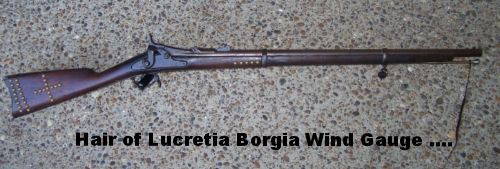The Accurate Reloading Forums
BPCR Long Range Capabilities
29 May 2014, 21:15
Idaho SharpshooterBPCR Long Range Capabilities
Sharpsguy has it right.
Rumors have it that Col Bodine used his influence to keep Farrow off the team. If you read Farrow's book, "How I Became A Crackshot", he toured Europe a couple years and won just about every match he entered.
Want to make a lifelong friend in the BPCRS/Long Range fraternity? Souvenir them a real copper penny.
29 May 2014, 23:06
sharpsguyI don't doubt that there were politics involved in keeping Farrow off the team. He WAS a brilliant shot. He was also quite a bit younger than the other shooters in that circle, and not exactly bashful about his shooting prowess. He rubbed some of the wrong folks the wrong way, and they couldn't beat him on a regular basis, so they had the NRA ban him.
Sharpsguy, thanks for the parts list.
Yes, I know how to google:

Shiloh Montana Roughrider:
http://www.shilohrifle.com/sho...ct.php?productid=112 
Red River Mega Soule:
http://www.buffaloarms.com/Red...164078.aspx?CAT=4073 
Montana Vintage Arms catalog (big PDF takes a while to download), #111 globe sight is on page 16:
http://www.montanavintagearms....pdfs/mva_catalog.pdfLyman 17A globe sight:
http://www.lymanproducts.com/l...ights/series-17a.php 
Those must be some respectable hardware.

30 May 2014, 15:04
Idaho SharpshooterShould we tell them about the Billy Dixon Shoot?
A 45-70 won't quite get to the 1520(?)yd shot with available vernier tang rear sights, but Mike Venturino did with his 50-90 at the Yuma Proving Grounds in front of the staff there several years back.
His books on shooting the Buffalo Rifles are well worth owning.
Rich
30 May 2014, 16:49
sharpsguyISS--According to Venturino's account of the tests at Yuma, it took 5 to 5 1/2 degrees of elevation for the 50-90 and the 45-110 to reach 1520 yards. He didn't give the elevation in MOA values on a tang mounted vernier, but said that it was easily attainable with the rear barrel sight. I do know that with a setting for 1100 yards on the sight ladder of my rifles that carry the Lawerence low notch carbine sight, I have a bit over 1/2 inch elevation that is still available. I haven't tried it, but I am fairly certain I can reach 1520 yards with my 45-70, as my elevation setting for 1000 yards at Raton is 164, and I have 250 available on my Mega Soule. I am actually more confident that the barrel ladder sight will reach it than I am with the vernier.
30 May 2014, 17:52
larry bryantDon't remember how far it was to the white buffalo at Raton but I managed to hit it 4 times in a row on a calm mourning with a 40-65 and snover bullet.
Of course, everybody knows about the Billy Dixon 1538-yard shot that saved the day at Adobe Walls in 1874.
Even me.

Mike Venturino did a great job recounting it in
SHOOTING BUFFALO RIFLES of the OLD WEST,
page 228, in chapter about Billy Dixon (reprint of Sep 1994 SHOOTING TIMES article):
"... This rifle could have been either a .50-70 or a .50-90, as the hunters referred to either as "Big .50." ... "Hair of Lucretia Borgia!!! Though Billy did it with a Sharps, probably 50-90, brought out in 1872 by Sharps.

Hey, just a newbie question....what are the circular apertures seen above for the front sight? How are they used?
Biebs,
They are peep-aperatures placed inside the tunnel front sight, so you are centering the target inside the front aperature as well as looking at it through the pin-hole rear aperature.
Double peeping.
Bound to be accurate on a long barrel, if you can see well enough to use them!

04 June 2014, 01:52
Bill/OregonMr. Bagwell is one of the finest living Sharps rifle shooters, and I am not surprised at his groups!
Cal, I think one reason we see the Sharps do so well at distance is that the ones that made the rifle's reputation were often built with very heavy and stiff barrels, as distance work was the primary end use.] and weight was often not an issue at all. So many of the British best houses were more focused on building light and lively sporting rifles that handled like dreams in the game fields -- wonderful weapons to carry for game shooting, not so great for long-range target work.
There is hope, even when your brain tells you there isn’t.
– John Green, author


